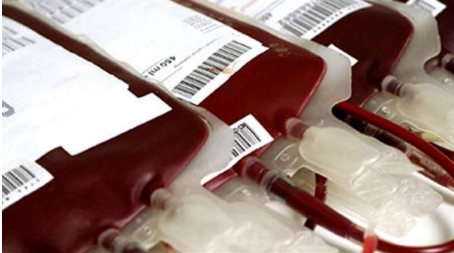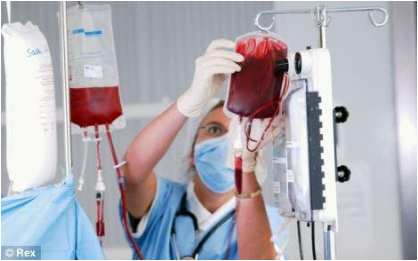Everything you need to know about red blood cell transfusion
Article by doctor of Hematology - Blood Transfusion - Laboratory Department - Vinmec Ha Long International General Hospital.
Red blood cells are prepared from whole blood by centrifugation and separating 80-90% of the plasma, then adding a red blood cell culture solution containing dextrose, adenine and mannitol allowing a 42-day storage. Accordingly, the transfusion of red blood cells will be used to replace the lost blood in the recipient and correct the abnormalities in the blood without any alternative solution.
1. What are RBCs?
Red blood cells are prepared from whole blood by centrifugation and separating 80-90% of the plasma, then adding a red blood cell culture solution containing dextrose, adenine and mannitol allowing a 42-day storage. Red blood cells were stored at 40C. There are different types of red blood cells: Concentrated red blood cells, Preserved red blood cells, Washed red cells, irradiated red blood cells, and leukopenia.
Each unit of red blood cells with storage solution, volume 250 mL, with Hct from 0.50 - 0.70 L/L, will increase Hemoglobine by 10 g/L. Red blood cells do not contain clotting factors, so after a large transfusion, fresh frozen plasma must be given. The advantages of erythrocytes over whole blood are reduced risk of volume overload, reduced levels of citrate, ammonia and organic acids, and reduced risk of allo immunization due to the low antigenic content. Red blood cells rapidly increase oxygen carrying capacity in patients with acute or chronic blood loss.

Hồng cầu khối được bảo quản ở 40C
2. Indications for transfusion of red blood cells
Blood and blood products of human origin, will be used to replace blood lost in the recipient and correct abnormalities in the blood without any alternative solution.
Currently, blood and blood products are widely used in the treatment of Critical Care, Emergency, Internal Medicine, Surgery, Obstetrics, Pediatrics, Organ Transplant... and other specialties with The purpose is to restore blood volume and blood deficiency or to help patients resuscitate when receiving chemotherapy drugs that affect the bone marrow. In particular, in Obstetrics and Gynecology, bleeding during labor and delivery is a dangerous complication that, if not handled promptly and resuscitated, can cause death.
3. Which patient needs a red blood cell transfusion?
Patient's status of acute or chronic anemia, etiology of anemia, clinical manifestations of hypoxia, patient's compensatory capacity for blood loss and transfusion.
Patients with chronic anemia and at risk of circulatory overload, need a lot of hemoglobin to transport oxygen but do not want to increase the circulatory volume in: The elderly, young children, people with heart disease, surgery, bleeding Digestion causes a loss of about 15 to 25% of the body's blood volume. Kidney disease and cases of chronic anemia that cannot be treated with hematopoietic agents such as iron, vitamin B12, folic acid, recombinant erythroprotein, cases of severe bleeding due to trauma....
Severe blood loss due to surgery or accident, Gastrointestinal bleeding, Emergency Obstetrics and Gynecology with a lot of blood loss, Chronic Anemia, Support in the treatment of some diseases with anemia... Emergency blood transfusion: In an emergency situation, group O/group erythrocytes are the only blood products that can be used even though the cross-reaction/blood group has not yet been able to save the patient's life.
Acute bleeding in trauma, gastrointestinal bleeding or ruptured abdominal aortic aneurysm. In healthy patients, <1500 mL of blood loss (25-30% of a 70 kg person's blood volume) can be completely compensated with fluids. If more than this is lost, red blood cell transfusions are needed to increase oxygen-carrying capacity and fluids to compensate for circulating volume.

Bệnh nhân thiếu máu mạn tính cần được truyền máu
Surgical blood loss: Hb < 70 g/L or surgery with a lot of blood loss.
Chronic anemia requires red blood cell transfusion if Hb < 70 g/L or if the patient has symptoms or cardiopulmonary disease.
In addition to red blood cells, there are other preparations such as poor red blood cells, frozen red blood cells, washed red blood cells for some special patients.

4. Unexpected complications when infusion of blood products/erythrocytes
Unexpected complications or transfusion reactions are reactions and manifestations that occur in patients related to blood transfusion and blood products.
Transfusion of blood/blood products is essential to ensure the patient's life. However, transfusion of blood/blood products can cause unwanted complications, which can be life-threatening if not performed correctly and controlled in time.
Accordingly, complications caused by blood transfusion/blood products may occur early or late. Therefore, only blood transfusion when absolutely necessary.
Complications occur early such as hemolysis due to wrong blood type ABO, Rh, hypothermia, tremor, allergies, acute pulmonary edema during transfusion... Late complications occur during blood transfusion include: infection , infection with viruses that cause blood-borne diseases such as hepatitis B, C, HIV, late hemolysis...
When an accident occurs, it should be handled promptly and according to the right regimen to ensure patient safety.

Truyền máu có thể xảy ra tai biến
5. Classification of complications when transfused red blood cells
5.1. Classify
Classification by mechanism
Immune disagreement Infection Infection Mass blood transfusion. Classification by severity:
Mild Moderate Severe Time classification:
Acute: Acute transfusion events occur from the start of the transfusion and within 24 hours of the transfusion. Late: Late transfusion events occur 24 hours to many days after transfusion.
5.2. Acute unwanted events
Allergic reaction - urticaria Febrile reaction after non-hemolytic blood transfusion Acute hemolytic infection Anaphylactic shock Blood transfusion acute lung injury (TRALI)
5.3. Late unexpected complications due to blood transfusion
Transmission of blood-borne diseases: HIV-1 and HIV-2, HTLV-1 and II, Hepatitis B and C, Syphilis, Malaria, Cytomegalovirus infection... Transfusion-associated graft-versus-host disease (GvHD) ). Hemorrhage after blood transfusion Complications due to large volume blood transfusion: Hemodynamic disorders, Citrate toxicity, Hypothermia, Transfusion iron...
5.4. Early detection signs and clinical symptoms
Restlessness, anxiety, irritability, lethargy, loss of consciousness; Back pain, stomach pain, headache; Fever or chills; Papules, rashes, urticaria; Tachycardia, low blood pressure, pulse collapse, shortness of breath, respiratory failure; Nausea, vomiting, Sudden bleeding in previously stopped wounds, failure to stop bleeding from new wounds, bleeding that does not clot, Hemoglobinuria... Vinmec International General Hospital is the address. examination, treatment and prevention of diseases. When performing the examination process at Vinmec, customers will be welcomed and used modern facilities and equipment along with perfect medical services under the guidance and advice of experts. Good doctors, well-trained both at home and abroad.
Customers can directly go to Vinmec Health system nationwide to visit or contact the hotline here for support.
REFERENCES
Ministry of Health (2013). Circular 26/2013/TT-BYT dated September 16, 2013 “Guiding blood transfusion activities”. Department of Hematology-Blood Transfusion, Hanoi Medical University (2014). Lecture on Hematology-Blood Transfusion (Graduate). Medical Publisher...
Bài viết này được viết cho người đọc tại Sài Gòn, Hà Nội, Hồ Chí Minh, Phú Quốc, Nha Trang, Hạ Long, Hải Phòng, Đà Nẵng.






